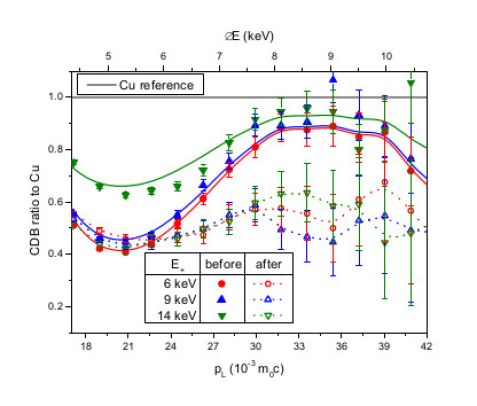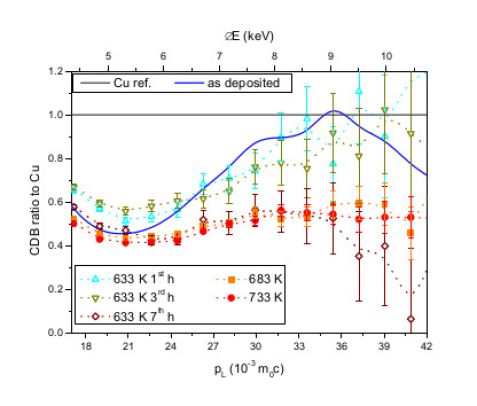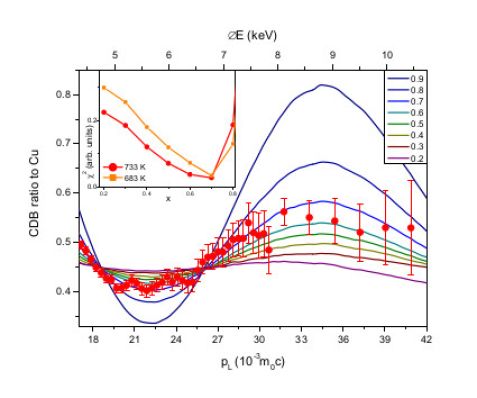MLZ is a cooperation between:
 > Technische Universität München
> Technische Universität München > Helmholtz-Zentrum Hereon
> Helmholtz-Zentrum Hereon
 > Forschungszentrum Jülich
> Forschungszentrum Jülich
MLZ is a member of:
 > LENS
> LENS > ERF-AISBL
> ERF-AISBL
MLZ on social media:

MLZ (eng)
Lichtenbergstr.1
85748 Garching
Thin film annealing and alloying of a Au/Cu two-layer system studied using a positron beam
M. Reiner, T. Gigl, C. Piochacz, C. Hugenschmidt
Heinz Maier-Leibnitz Zentrum (MLZ) and Physik Department E21, Technische Universität München, Lichtenbergstraße 1, 85748 Garching, Germany
The high temperature behavior of a Au(d = 180 nm)/Cu(d = 480 nm) two-layer system was studied using Positron Annihilation Spectroscopy (PAS). For this purpose, defect sensitive and element specific Coincident Doppler Broadening Spectroscopy (CDBS) with a monoenergetic positron beam was applied. In-situ CDBS during isothermal tempering at 633 K for 7 h enabled the observation of both annealing of the Au film and alloying of Au and Cu. The changes in the recorded spectra could be separated into two stages: In the first stage, annealing in the Au film was detected, whereas in the second stage intermixing of Au and Cu atoms was observed. The intermixing zone was found to be homogeneous up to a depth of more than 180 nm. In addition, ab initio calculations were performed in order to estimate the composition of the alloyed film, which was found to be Au0.7Cu0.3
Element specificity of PAS
In the present study [1], the high-intensity positron beam NEPOMUC at the FRM II was used in order to study the tempering of a two-layer system of Au and Cu on a Si substrate. Therefore, depth dependent CDBS of the positron annihilation line was applied. The Doppler broadening is caused by the momentum component of the annihilating electron-positron pair pL longitudinal to the emission direction of the annihilation -quanta. With this technique, high Doppler shifts stemming from the annihilation with core electrons can be detected and hence, an element specific analysis of the surrounding of the annihilation site is possible. The interpretation of the data can be supported by the ab-initio calculation of CDB spectra. Moreover, the CDB signature can also be used to investigate the presence of open volume defects, which trap positrons with high efficiency. Usually, it is not the raw CDB spectra that are analyzed but the so-called ratio curves to a reference spectrum, which here has been measured for Cu.
Depth profiling with positrons
The thin film system was produced by vapor deposition on a Si(100) substrate. A Au film of 180 nm thickness was deposited on top of a 480 nm thick Cu film. In EDX measurements, the chemical purity of the system was confirmed. X-ray diffraction revealed that both films were polycrystalline with a typical grain size around 30 nm. Afterwards, the system was investigated by depth dependent CDBS. The incident beam energy E+ was adjusted in order to probe different depth regions of the two-layer system. By precisely modelling both the positron implantation and diffusion, the E+ dependent depth distribution of the annihilating positrons can be determined. According to this information, Cu and Au reference spectra were superposed and the calculated spectra shown in fig. 1 (solid lines) were obtained. One can see at E+ = 6 keV a CDB signature typical for Au. The approach of the ratio curves to the Cu reference with increasing E+ is caused by a higher fraction of positrons annihilating in the Cu film. Theoretical and measured spectra are in very good agreement in the element specific high momentum area, which clearly demonstrates the great potential of positron beams for the investigation of thin films and multilayer systems.
In-situ CDBS at high temperatures
Then, the investigated system was heated up to a maximum temperature of 733 K and CDB spectra were detected in-situ. This experiment could only be conducted due to the extraordinarily high intensity of the NEPOMUC positron beam which allows high-quality CDB spectra to be detected within short measurement times. For this experiment, the new high-temperature sample holder of the CDB-spectrometer was used, which allows measurements at up to 1160 K with the sample biased to high voltages up to 30 kV. During tempering, spectra clearly kept changing at a temperature of 633 K for 7 hours (fig. 2). Following a detailed analysis of the CDBS spectra (see [1] for details), these changes could be attributed to two effects: In the first three hours, it was mainly the annealing of the Au film that was detected. Later, the intermixing of Au and Cu atoms is the dominating process visible in CDBS, as is shown in the following. Tempering for longer times or at higher temperatures did not further change the CDB spectra and hence, the examined system was in thermodynamic equilibrium.
Calculational analysis of CDBS results
The CDB spectra detected in thermodynamic equilibrium are explained by the intermixing of Au and Cu atoms at the former interface of both layers. In order to estimate the Au content in the intermixing zone, CDB spectra were calculated for the disordered fcc phase of AuxCu1-x (see [3] for details). The Au content x was varied between 0.2 and 0.9 and the theoretical spectra were compared to the one measured at 733 K (fig. 3). For x=0.7 very good agreement was found and hence, the composition of the intermixing zone can be estimated to be Au0.7Cu0.3. In order to probe the homogeneity of the intermixing zone, depth dependent CDBS was conducted after cooling down. Independently of the incident beam energy E+, a CDB signature similar to the Au0.7Cu0.3 one was found (fig. 1). Hence, it is concluded that Cu atoms penetrated the complete Au film and that the intermixing zone is homogeneous in depth.
References:
[1] M. Reiner, P. Pikart, and C. Hugenschmidt, J Alloy Compd 587 (2014) 515–519
[2] M. Reiner, P. Pikart, and C. Hugenschmidt, J. Phys: Conf. Ser. 443, no. 1, 012071 (2013).
[3] M. Reiner, T. Gigl and C. Hugenschmidt, J. Phys: Conf. Ser. 505, 012025 (2014).
MLZ is a cooperation between:
 > Technische Universität München
> Technische Universität München > Helmholtz-Zentrum Hereon
> Helmholtz-Zentrum Hereon
 > Forschungszentrum Jülich
> Forschungszentrum Jülich
MLZ is a member of:
 > LENS
> LENS > ERF-AISBL
> ERF-AISBL
MLZ on social media:





